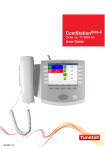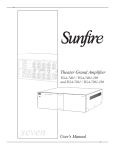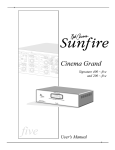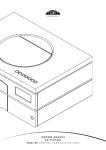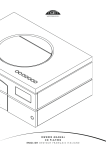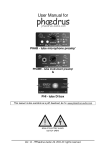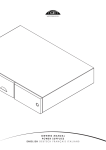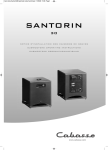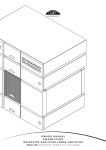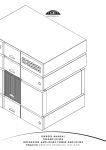Download Dali IKON 1 Operating instructions
Transcript
IKON ® manual 951006-0-0 C CAUTION RISK OF ELECTRIC SHOCK DO NOT OPEN CAUTION: RISK OF ELECTRIC SHOCK DO NOT OPEN CAUTION: TO REDUCE THE RISK OF ELECTRIC SHOCK, DO NOT REMOVE THE BACK PANEL. NO USER-SERVICEABLE PARTS INSIDE. REFER SERVICING TO QUALIFIED PERSONNEL. The lightning flash within an equilateral triangle is intended to alert you to the presence of uninsulated „dangerous voltage“ within the product’s enclosure that may be of sufficient magnitude to constitute an electric shock to persons. 1. Read Instructions - All the safety and operating instructions should be read before the appliance is operated. 2. Retain Instructions - The safety and operating instructions should be retained for future reference. 3. Heed Warnings - All warnings on the appliance and in the operating instructions should be adhered to. 4. Follow Instructions - All operating and use instructions should be followed. 5. Water and Moisture - The appliance should not be used near water - for example, near a bathtub, washbowl, kitchen sink, laundry tub, in a wet basement, or near a swimming pool and the like. 6. Carts and Stands - The appliance should be used only with a cart or stand if recommended by the manufacturer. 7. Wall or Ceiling Mounting - The appliance should be mounted to a Wall or ceiling only as recommended by the manufacturer. 8. Ventilation - The appliance should be situated so that its location or position does not interfere with proper ventilation. For example, the appliance should not be situated on a bed, sofa, rug, or similar surface that may block the ventilation openings; or placed in a built-in installation, such as a bookcase or cabinet, that may impede the flow of air through the ventilation openings. 9. Heat - The appliance should be situated away from heat sources such as radiators, heat registers, stoves, or other appliances that produce heat. 10. Power Sources - The appliance should be connected to a power supply only of the type described in the operating instructions or as marked on the appliance. 11. Power Cord Protection - Power-supply cords should be routed so that they are not likely to be walked on or pinched by items placed on or against them, paying particular attention to cords at plugs, convenience receptacles and the point where they exit from appliance. 12. Cleaning - Do not use any liquid cleaners. Use only a dry cloth to wipe off dust and grease. 13. Non-use Periods - The power cord of the appliance should be unplugged from the outlet when left unused for a long period of time. 14. Object and Liquid Entry - Care should be taken so that objects do not fall and liquids are not spilled into the enclosure through openings. 15. Damage Requiring Service - The appliance should be serviced by qualified personnel when: a) b) c) d) e) 16. 2 The exclamation point within an equilateral triangle is intended to alert you to the presence of important operating and maintenance (servicing) instructions in the literature accompanying the appliance. The power-supply cord or the plug has been damaged; or Objects have fallen, or liquid has been spilled into the appliance; or The appliance has been exposed to rain; or The appliance does not appear to operate normally, or exhibits a marked change in performance; or The appliance has been dropped, or the enclosure damaged. Servicing - The user should not attempt to service the appliance beyond that described in the operating instructions. All other servicing should be referred to qualified service personnel. Contents Page Danish Audiophile Loudspeaker Industries .................................................................. 4 Unpacking .................................................................................................................... 5 Break-in ........................................................................................................................ 7 Setup - wide dispersion ............................................................................................... 7 Placement .................................................................................................................... 8 Placement of IKON VOKAL ............................................................................................. 9 Wall-mounting the IKON 1 & ON WALL........................................................................... 10 Connection ................................................................................................................... 11 Single wiring - IKON 1, ON WALL , VOKAL 1 ..................................................................... 12 Bi-wiring - IKON 2, 5, 6, 7, VOKAL 2 ............................................................................... 12 Connection of DALI IKON SUB ...................................................................................... 13 Connection to surround amplifier with separate subwoofer output ................... 13 Connection to a stereo pre-amplifier .................................................................. 14 Level adjustment ................................................................................................. 15 The listening room ....................................................................................................... 17 Power and acoustic pressure ....................................................................................... 18 DALI - more than meets the eye .................................................................................. 19 Tips and advice from DALI ........................................................................................... 20 Cleaning and maintenance ........................................................................................... 20 Technical specifications ............................................................................................... 21 3 Danish Audiophile Loudspeaker Industries Thank you for selecting DALI IKON loudspeakers. DALI is acclaimed around the world for unique It is important to us that your new DALI loud- loudspeakers built to our uncompromising stand- speakers are set up and connected optimally. For ards for design and performance. this reason, we recommend that you read this manual and follow its instructions. The goal for every single DALI loudspeaker is always our foremost commitment: To create a This manual contains instructions for setup and listening experience in your home that will make connection, as well as tips and advice on how you forget time and place. to get the most out of your new loudspeakers. Remember to sign up for our e-mail newsletter at www.dali.dk. 4 Enjoy. Unpacking Unpacking: Tool kit for IKON 5, 6, 7 Carefully unpack the loudspeakers of the box. 1. Aluminium foot, 4 pcs. Dependant on which DALI IKON model you have 2. M8 screw, 4 pcs. bought, different accessories comes with the 3. M8 nut, 4 pcs. loudspeaker, which you can read about in the fol- 4. Rubber foot, 4 pcs. lowing chapters. 5. M8 spike, 4 pcs. 6. 5 mm Allen key, 1 pc. Grille fronts: 7. 13 mm fork wrench, 1 pc. The speakers are delivered with the grille fronts already mounted when you unpack them. If you 7 2 wish to remove the grille front, loosen it by gradually tugging at the 6 metal plungers that hold it in place. It is important that all 6 are equally loosened before removing the front. Otherwise, the 3 6 4 grille may be damaged. 5 1 Tool kit for IKON SUB Figure 2. Tool kit for IKON 5, 6, 7 1. M8 nut, 4 pcs. 2. Rubber foot, 4 pcs. Tool kit for IKON 1, 2, VOKAL 1, 3. M8 spike, 4 pcs. VOKAL 2, ON WALL 4. 13 mm fork wrench, 1 pc. 1: Bumper, 4 pcs. 2 4 1 1 3 Figure 1. Tool kit for IKON S UB Figure 3. Tool kit for IKON 1, 2, VOKAL 1, VOKAL 2, O N WALL 5 Spikes: Rubber feet: On some floor surfaces and in some rooms, The enclosed rubber feet may be used instead the use of spikes is a crucial aspect of obtain- of spikes. The rubber feet can be mounted on ing the best result. The spikes (included) the aluminium feet over the thread holes for the should be screwed in loosely in the four spikes. aluminium feet, leaving the spike’s nut only slightly tightened. Using the screws (included), mount the feet in the threaded holes in the bottom of the speaker. Push the feet against the cabinet before tightening the screw. Place the loudspeaker upright on its spikes on the floor, so that it stands steadily without rocking. Tighten the nuts, so that the four spikes sit tightly in the aluminium feet. These assembly and setup steps ensure stable mechanical coupling to the surface beneath. 6 Figure 4. Mounting spikes Break-in Like any mechanical system, a loudspeaker requires a “break-in” period. You will experience a gradual increase in sound quality during an initial period. Unlike other mechanical systems, the lifespan of a loudspeaker is increased by regular use. Figure 5. DALI IKON bass driver Setup - wide dispersion DALI IKON is a prime exponent of one of the many virtues that have made DALI famous worldwide – Wide Dispersion. Wide Dispersion means that the area in front of the loudspeakers where a full stereo image is achieved is a great deal wider than with other loudspeakers. This ensures substantially better sound across a larger area within your listening room. To take full advantage of DALI IKON’s Wide Dis- Figure 6. DALI IKON High frequency module: Soft dome tweeter and ribbon tweeter persion, the loudspeakers should face straight ahead and not be angled in towards the listening position unless the two loudspeakers are placed very far apart. The IKON tweeter module is especially developed for this loudspeaker. Its unique design ensures that Wide Dispersion is more than just a name – you can tell the difference. 7 Placement Before setting up and connecting your new DALI IKON loudspeakers, you should find the best possible placement relative to your listening position. It is a good idea to follow these simple guidelines: Avoid as far as possible any objects between the loudspeakers and the listening position. Obstacles can have a detrimental effect on tonal balance. Figure 7. Stereo setup Ideally, the distance from the listening position to each loudspeaker should be the same as the distance between the left and right loudspeakers (Figure 7). In a surround installation, the speakers should be placed in a symmetrical configuration (Figure 8). Figure 8. Surround setup 8 Placement of IKON Vokal The IKON VOKAL center speakers have been specially designed to be positioned close to the large surface of the TV screen - and can be placed either above or below the screen, as required. Whether you position the center speaker above or below your TV, we recommend having the front of the speaker in line with the front of the TV. We recommend fitting the enclosed rubber feet to ensure a stable, vibration-free setup. Figure 9. Placement above TV-screen Figure 10. Placement below TV-screen 9 Wall-mounting the IKON 1 & IKON On Wall DALI IKON 1 There are several placement options for DALI On the rear panel of DALI IKON ON WALL, there IKON 1: on a stand, on a shelf, on a table-top or are four indentations to make room for loudspea- wall-mounting. ker cable between the speaker and the wall. This allows you to run cable along either side up or For the best possible sound, we recommend pla- down depending on what works best for you. cement with the tweeter module at roughly the same height as your ears when you are seated in your favourite listening position. For wall-mounting of DALI IKON 1, use the builtin bracket on the speaker’s rear panel. Mount the included rubber feet on the rear of the speaker to avoid scuffing the wall and to ensure secure mounting. Hang the loudspeaker on a screw that sits firmly in the wall. You must make certain that the screw can bear the weight of the speaker as stated in the technical specifications. The diameter of the screw head should be 8 - 10 mm and the diameter of the screw should be max. 4 mm. Figure 11. Wall-mounting IKON 1 DALI IKON ON WALL DALI IKON ON WALL is designed for wall-mounting. Because the loudspeaker can be positioned four different ways, there are four brackets on the rear panel. The speaker can be used as front, rear, side or center loudspeaker. If used as center loudspeaker, it can be placed above or below the TVscreen. For wall-mounting, follow the instructions above for DALI IKON 1. Figure 12. Wall-mounting IKON O N WALL 10 Connection Correct, tight connections to your amplifier are Make sure that the conductors are tightly gripped extremely important for your listening experience. by the terminals with no loose wires that could cause a short circuit and damage the amplifier Before connecting cables or changing any con- (Figure 14). nections, ALWAYS turn off your amplifier. The DALI IKON terminals are well-suited to plugs. Always use cables of the same type and length We recommend DALI Connect Banana Plugs. for left and right channels. We recommend using special speaker cables from DALI, available from your dealer. Connection in correct phase is a detail that is often ignored. The red (+) terminal of the amplifier must be connected to the red (+) terminal of the loudspeaker. The black (-) terminal of the amplifier must be connected to the black (-) terminal of the loudspeaker (Figure 13). For the optimal listening experience, the right loudspeaker (as seen from the listening position) must Figure 13. Amplifier connections be connected to the amplifier output terminals marked “R” or “Right.” The left loudspeaker must be connected to the amplifier output terminals marked “L” or “Left.” Even a single loudspeaker connected out-of-phase in a stereo or surround installation will make the bass weaker and the stereo image unfocused. If you are using DALI IKON in a surround system, follow the instructions included with your surround amplifier. Figure 14. Connecting bare loudspeaker wire 11 Single wiring - IKON 1, On Wall, Vokal 1 For normal single wiring, connect loudspeaker cable as shown (Figure 15.). Figure 15. Single wiring Bi-wiring - IKON 2, 5, 6, 7, Vokal 2 The top terminal pair is internally connected to the crossover network’s high frequency section. The bottom terminal pair is internally connected to the crossover network’s bass section. When bi-wiring or bi-amping, ALWAYS remove the metal jumpers between the terminals before connecting cables. For bi-wiring, connect two sets of loudspeaker cable, one to the top terminals and one to the bottom terminals. At the amplifier end, connect both sets of loudspeaker cables to the same pair of terminals on the amplifier (Figure 16). 12 Figure 16. Bi-wiring Connection of DALI IKON Sub When using the IKON subwoofer with active The DALI IKON SUB can be connected to the crossover and built-in power amplifier in your subwoofer output of your surround amplifier or stereo or surround system, there are two connec- to the line output of your stereo pre-amplifier. tion options. Connection to surround amplifier with separate subwoofer output If you want to use DALI IKON SUB for reproduc- SURROUND AMPLIFIER tion of the special subwoofer signal from a sur- LFE/Subwoofer LINE OUT round amplifier with separate subwoofer output terminal, connect this to the LFE input terminal on IKON SUB. If the LFE input terminal is selected, the crossover network in IKON SUB is not active. The LFE input terminal should therefore only be used together with a special subwoofer output terminal in which the signal has already been filtered, so the Figure 17. Connection to surround amplifier with separate subwoofer output subwoofer only receives the lowest frequencies. 13 Connection to a stereo pre-amplifier If you want to use IKON SUB to supplement the bass reproduction of a stereo system, connect PRE-AMPLIFIER LINE OUTPUT the subwoofer "Line in, Left/Right" to a stereo signal on the pre-amplifier with full frequency content. The built-in crossover network in IKON SUB then ensures that the subwoofer only reproduces the lowest frequencies (see section on level adjustment and adjusting the crossover on page 15 and 16). In most cases you will achieve excellent results with one IKON SUB. It is possible as a no-compromise stereo solution, or for reproduction of very powerful sound pressure in a surround setup in large rooms, to use two IKON SUBs. This solution is connected in the same way, but for stereo you should only connect the left-hand channel to one input terminal on the left-hand IKON SUB and the right-hand channel to one input terminal on the right-hand IKON SUB. For a surround setup, parallel the LFE inputs of the two IKON SUB. In all other respects, follow the instructions above - but use separate channels. You may wish to consult your dealer. Note: When using two IKON SUB, the best results are normally achieved by positioning the two subwoofers relatively close to each other (1 - 2 metres). 14 LINE IN POWER AMPLIFIER Figure 18. Connection to stereo preamplifier Level adjustment When you have decided upon which method amount of bass present in the music/soundtrack, of connection you want and positioned the no more and no less. If installing the IKON SUB in subwoofer, you can commence the exciting a surround system, it is practical to select a fixed process of tuning the system. Please note that level on the IKON SUB and adjust subwoofer positioning the subwoofer will have a lot of output using the surround amplifier's setup func- influence on its contribution to the overall sound. tion. If bass levels are set too high, distortion will If for example, the IKON SUB is positioned in a reduce the quality of your listening experience. corner, the bass will be much heavier than if it is Please note that the position of the subwoofer positioned midway between two corners. will have major influence on its sonic contribution. The following tuning methods are recommended to achieve the best results. Use a piece of music you know well, and that preferably includes rhythmic bass such as kettle drums, bass guitar etc. Start with "Volume" in the middle of the dial (12 o’clock). Turn the "Phase" to position 180°, and "Power" to the "ON" position. Level adjustment Adjust the volume of the IKON SUB so that the bass matches the level of the front speakers. You should be able to appreciate the IKON SUB's contribution to the sound, without it ever being over-powering. Bass must be tight and accurate, so that the subwoofer reproduces the exact Figure 19. Adjusting IKON S UB 15 Adjusting the crossover frequency (only Selecting Auto function when using ”LINE IN, Left/Right” inputs) The "Auto" function puts the IKON SUB into Once the volume level is finalised, you can start stand-by after approx. 10 minutes with no signal on the equally important adjustment of the over- received at the input. When IKON SUB receives a lap between the front loudspeakers and the IKON signal once more, the subwoofer’s amplifier starts SUB. To do so, adjust up and down using "Cros- up automatically. sover" until you can hear that the bass is even and with no drop-out. You may have to adjust the The "Power" button is the main on/off switch. We volume again. recommend switching off the system when it is not to be used for long periods. When connecting Setting phase or changing connections, always disconnect the Try different settings – if necessary combined main electricity. with new adjustment of volume and crossover frequency. Select the position that provides the Overloading smoothest transition between the main speakers If the IKON SUB is seriously overloaded, the built- and the subwoofer. The choice may be difficult, in safety circuit will cut the power off. If this oc- but it often pays to experiment extensively in your curs, turn the system down and the IKON SUB will search for the best sound. In any event, it is a automatically come on-line again after a short good idea to listen to the system for a few days period. before making any final adjustments. Using the same setting for surround and 2-channel stereo The built-in safety circuit is not a guarantee does not always achieve the best results. It is the- against damage as a result of overloading, which refore a good idea to note the setup you prefer for is why the recommendations regarding sound surround and stereo. pressure etc., to be found on page 18 should be followed. 16 The listening room Every room has its own distinctive acoustics, which As a basic rule, try to avoid large, hard and reflec- influence the way we experience the sound from tive areas in the immediate vicinity of your loud- a speaker. In actual fact, it's a matter of how the speakers. In the same way that a mirror reflects room accommodates the sound and then damps light, they will reflect sound from the speakers at it. You can influence the acoustics of your listening almost full strength but with a slight delay due to room in various ways. the relatively low speed of sound. This will disturb the precision and spacial effect of sound reprodu- Some of the sound you hear comes not from the ction. Try hanging a soft textile surface behind the actual speakers but from reflections from floor, speaker, place a rug in front of it, or place a large ceiling and walls. These reflections are damped by plant to the side and experience the surprisingly objects such as furniture, plants and carpets. If the large effect doing so will have on the quality and sound is bright, soft items such as curtains and precision of the sound. carpets can help. If the room has large window panes, drawing the curtains will prevent reflec- Once you are happy with the positioning of your tions from the glass surfaces. speakers, it is important to ensure that they are completely stable. For floor models it is essential Both the amount and quality of the deep bass that you use the accompanying spikes. depend on the size and shape of the room, and the position of the speakers. If positioned near a side or back wall, this will accentuate the bass. A corner location will accentuate it even more, but will also increase the reflections. The decision is yours, so experiment with different positions to find which provides the ideal sound for you. 17 Power and acoustic pressure How loud a speaker is able to play and still sound in the system. So, DALI recommends that the good is completely dependent on the signal it has tone controls generally be set to the neutral posi- to reproduce. So, in practice, you cannot define an tion, and you achieve your desired sound image unequivocal level for use in comparing different through correct positioning of the speakers. speakers. Ensuring that you keep the volume low enough so Obviously, lots of pure, undistorted output from the sound remains clear and undistorted will mini- a large amplifier is better than a distorted signal mise the strain on both speakers and amplifier. from a small amplifier stretched beyond its capacity. The signal from a distorting (clipping) amplifier All DALI loudspeakers are designed with linear contains much more high-frequency information impedance to be an optimal amplifier load. The than an undistorted signal, and therefore puts a result is significantly more open and detailed heavy strain on the tweeter. Consequently, speak- sonic image. ers are most often damaged by small amplifiers having to work too hard - and very rarely by large amplifiers, which are practically running idle. It is worth noting that when the tone controls are turned above the neutral setting this significantly burdens both speakers and amplifier. On a good sound system tone controls should only be used to compensate for poor recordings and not to permanently compensate for weaknesses elsewhere 18 DALI - more than meets the eye Your DALI loudspeakers incorporate a wide range of technical solutions based on many years of intensive research and experience. Most of it can’t be seen, but can be heard and enjoyed. These design principles include: Wide Dispersion DALI designs drivers and crossovers to produce wide, even sound dispersion, resulting in outstanding room integration, a larger sweet spot and a wider listening area. Time Coherence The unique DALI drivers, optimised cabinets and carefully tuned cross-overs ensure optimal time coherence in the reproduced sound. 3D Audio DALI’s time coherence and low-loss technologies create a transparent, holographic, three-dimensional sounds. Low-Resonance Cabinets Specially designed cabinets reduce resonances and coloration of the sound, achieving a natural, realistic sound. Amplifier Friendly DALI’s linear impedance design ensures an audible reduction of amplifier instability and coloration. Hand Crafted Hand assembled from the fitting of the cabinet to final electro-acoustic testing, each and every speaker is personally approved and signed by the person who assembled it. 19 Tips and advice from DALI DALI loudspeakers should never be angled in As a general rule, your amplifier’s tone controls towards the listening position, unless the speak- (bass and treble) should remain in a neutral posi- ers are very far apart. tion. Always turn off the amplifier, before connecting Use the spikes or rubber feet included with the or disconnecting any cables. loudspeakers – they make a significant contribution to sound quality and ensure that your loudspeakers stand firmly. Cleaning and maintenance Clean the cabinets with a soft, dry cloth. If the cabinets are dirty, wipe with a soft cloth dipped in all-purpose cleaner and then well wrung out. Be very careful when wiping the speaker cones, as they are very fragile. Fabric frameworks can be vacuumed and wiped with a well-wrung, lint-free cloth and mild all-purpose cleaner. 20 Technical specifications There are countless methods for measuring DALI IKON loudspeakers are designed to repro- speakers. However, none of them tell you any- duce music as honestly as possible. thing useful about how a speaker really sounds. Only your ears can decide whether one speaker Enjoy your new speakers! sounds better than another. IKON 1 IKON 2 IKON 5 43-30,000 42-30,000 39-30,000 87.0 88 88 8 8 8 106 108 109 2,900/14,000 3,000/14,000 600/2,700/14,000 47 41 37 Enclosure type Bass reflex Bass reflex Bass reflex Recommended placement Wall / Shelf Stand Floor Rec. amplifier power [Watt] 25-100 30-120 30-125 Frequency range +/- 3 dB [Hz] Sensitivity (2.83 V/1m) [dB] Nominal impedance [ ] Maximum SPL [dB] Crossover frequencies [Hz] Bass reflex tuning frequency [Hz] Amplifier power [Watt] - - - High frequency driver(s) 1 x 28 mm soft dome 1 x 28 mm soft dome 1 x 28 mm soft dome 1 x 17 x 45 mm ribbon 1 x 17 x 45 mm ribbon 1 x 17 x 45 mm ribbon 1 x 5” 1 x 6½” 2 x 5” Single wire Bi-wire Bi-wire Low frequency driver(s) Connection input(s) Dimensions (HxWxD) [cm] Dimensions (HxWxD) [inches] Function(s) Weight [kg/lb] Finish 35 x 15 x 26 44 x 19 x 30 81 x 15 x 26 13.8 x 5.9 x 10.1 17.3 x 7.4 x 11.7 31.9 x 5.9 x 10.2 - - - 5.2/11.46 9.0/19.84 11.8/26.01 Light Oak / Light Walnut Light Oak / Light Walnut Light Oak / Light Walnut 21 Frequency range +/- 3 dB [Hz] Sensitivity (2.83 V/1m) [dB] Nominal impedance [ ] Maximum SPL [dB] Crossover frequencies [Hz] Bass reflex tuning frequency [Hz] Enclosure type IKON 7 IKON VOKAL 1 37-30,000 36-30,000 78-26,000 91.5 92 87.5 6 6 8 111 112 107 800/3,200/14,000 600/2,900/14,000 3,000 36 35 70 Bass reflex Bass reflex Bass reflex Recommended placement Floor Floor Below / above TV screen Rec. amplifier power [Watt] 25-150 25-200 25-100 Amplifier power [Watt] - - - High frequency driver(s) 1 x 28 mm soft dome 1 x 28 mm soft dome 1 x 28 mm soft dome 1 x 17 x 45 mm ribbon 1 x 17 x 45 mm ribbon - 2 x 6½” 3 x 6½” 2 x 4” Low frequency driver(s) Connection input(s) Dimensions (HxWxD) [cm] Dimensions (HxWxD) [inches] Function(s) Weight [kg/lb] Finish Frequency range +/- 3 dB [Hz] Bi-wire Bi-wire Single wire 100 x 19 x 33 114 x 20 x 34 12 x 42 x 21 39.4 x 7.4 x 13.1 44.9 x 7.9 x 13.5 4.5 x 16.5 x 8.4 - - - 18.6/41.01 22.9/50.49 5.6/12.35 Light Oak / Light Walnut Light Oak / Light Walnut Light Oak / Light Walnut IKON VOKAL 2 IKON ON WALL IKON SUB 26-200 55-30,000 57-30,000 Sensitivity (2.83 V/1m) [dB] 89 89.5 - Nominal impedance [ ] 8 8 30K(L/R) 20K LFE 113 Maximum SPL [dB] Crossover frequencies [Hz] Bass reflex tuning frequency [Hz] Enclosure type 110 108 2,500/14,000 2,500/14,000 - 44.5 - 29 Bass reflex Closed Bass reflex Recommended placement Below / above TV screen Wall Floor Rec. amplifier power [Watt] 25-150 25-100 - - - 250 - Amplifier power [Watt] High frequency driver(s) Low frequency driver(s) Connection input(s) Dimensions (HxWxD) [cm] Dimensions (HxWxD) [inches] Function(s) Weight [kg/lb] Finish 22 IKON 6 1 x 28 mm soft dome 1 x 28 mm soft dome 1 x 17 x 45 mm ribbon 1 x 17 x 45 mm ribbon - 2 x 5” 1 x 6½” 1 x 12” long stroke RCA. Stereo (low-pass filtered), LFE (mono) Bi-wire Single wire 15 x 51 x 26 38 x 28 x 19 45 x 41 x 45 5.9 x 20.1 x 10.1 14.8 x 10.9 x 7.4 17.8 x 16.1 x 17.7 Volume, Crossover frequency, Phase - - 7.7/16.98 7.1/15.65 29.0/63.93 Light Oak / Light Walnut Light Oak / Light Walnut Light Oak / Light Walnut






















